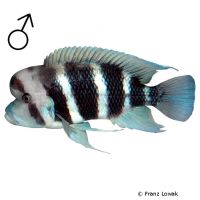Humphead Cichlid (Cyphotilapia frontosa)
| Humphead Cichlid Cyphotilapia frontosa | |
|---|---|
| Name | Humphead Cichlid |
| Name Lat. | Cyphotilapia frontosa |
| Synonym | Paratilapia fontosa |
| Family | Cichlids |
| Family lat. | Cichlidae |
| Order | Cichlids |
| Order lat. | Cichliformes |
| Origin | Lake Tanganyika |
| Habitat | Rocky habitat |
| Diet | Omnivore |
| pH | 7.5-9.0 |
| Behavior | Semi-aggressive |
| Keeping | Harem |
| Care Level | Moderate |
| Reproduction | Mouthbrooder |
| Breeding | Moderately difficult |
| Life Span | 6-8 years |
| Protection | No |
| Metric Units | |
| Size | 25-30 cm |
| Temperature | 24-28 °C |
| Hardness | 15-18 °dH |
| Aquarium | 500 l |
| US Units | |
| Size | 9.8"-12" |
| Temperature | 75-82 °F |
| Hardness | 267-320 ppm |
| Aquarium | 150 gal |
Distribution and habitat
Lake Tanganyika bumpheads are found exclusively (endemically) in Lake Tanganyika, where they have a seawide distribution and have produced several site variants. They live on rocky shores with stony substrates in 20-40 m water depth.
Maintenance
The aquarium setup should consist of rock structures with hiding places, such as crevices and caves, as well as some free sand areas, and plenty of free swimming space. For the fish living in deep water, the lighting should be somewhat shaded.
There should be no detectable ammonia, ammonium or nitrite, and the nitrate level should not exceed 100 mg/l. To ensure water quality and oxygen content, a filter and heater adapted to the aquarium size is required, as well as lighting for the species-appropriate day-night rhythm of the animals.
Diet
In the wild they feed on small fish, crustaceans, phytoplankton and algae. The food supply consists of strong live food, such as mysis, artemia, shrimp, smelt, and mussel meat, which is also easily accepted frozen, supplemented with commercially available frozen special food mixtures and cichlid pellets. In addition, they require vegetable food, such as over-scalded leafy and wild vegetables, algae leaves or high-quality dry food with vegetable components (kelp, spirulina). Regular and varied feeding promotes health and prevents deficiency symptoms. Only feed as much as is eaten immediately (in a maximum of 10 minutes).
Behaviour and compatibility
Lake Tanganyika bumpheads should be kept in a harem, one male with several females. They are very territorial within the species, so keeping multiple harems is only recommended in a larger and richly structured tank. They belong to the calm and most peaceful Lake Tanganyika cichlids and should only be socialized with other peaceful cichlids. Basically, only compatible fish species with similar demands on water condition and water temperature should be socialized.
Sex dimorphism
Males are usually larger, have longer fin ends and a more developed frontal hump. There is little difference in coloration between males and females.
Reproduction and breeding
They are maternal mouth brooders. Immediately after spawning on a rock, the females take the eggs into their throat sac for mouth brooding. They keep the fry in their throat sac even after hatching. After 4-6 weeks, the fry are released and brood care ends. Throughout brood care, the female does not consume food.
Fry must be fed several times a day with special rearing food. In community tanks breeding is hardly possible, because the fry are easy prey.
Important
Different site varieties should not be maintained together as they can cross (hybridize).
The well-being of the fish should be checked regularly. Temperature should be checked daily, pH, hardness and nitrate levels at least fortnightly. Regular partial water changes are recommended, even if the contaminant level has not yet reached the upper limit. Sudden changes in water quality should be avoided. Newly introduced fish must be accustomed slowly to the water in the aquarium.
Further literature can be found in your pet store.
References
Text: Werner Winter; Image: Franz Lowak
Source: BMELV (1998): Tierschutzgutachten - Haltung von Zierfischen (Süßwasser); RIEHL & BAENSCH (2006): Aquarien Atlas Bd. 1, Mergus Verlag; ENGELMANN (2005): Zootierhaltung - Tiere in menschlicher Obhut: Fische, Verlag Harri Deutsch
- Gemäß § 21 Abs. 5 Tierschutzgesetz idgF
